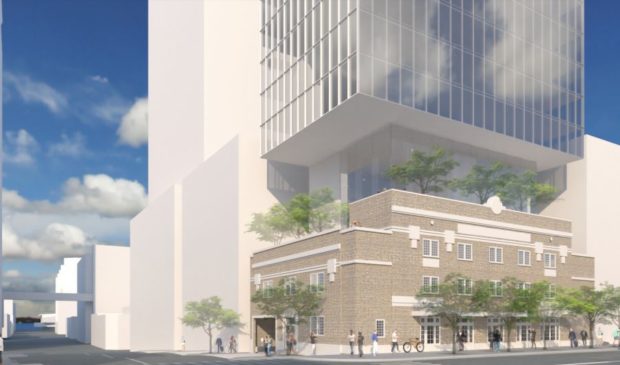Commissioner calls modern addition to Masonic Lodge a ‘desecration of an actual landmark’
Wednesday, June 26, 2019 by
Jessi Devenyns In a collaborative effort, the Austin-based Mason Chapter of the York Rite began working with the city’s Historic Preservation Office and several local architecture firms to design a structure that would allow the Masons to retain their ancestral lodge on the corner of Seventh and Lavaca streets, while providing the economic security needed to keep the property under the brotherhood’s watch.
According to preliminary designs that came before the Historic Landmark Commission on June 24, the interior of the three-story lodge would be excavated and the structure transformed into a 30-story-plus tower. Plans show a three-story glass atrium separating the Austin historic landmark on the bottom from the modern high-rise that looms above it.
As for the use, that is yet to be determined. Brett Rhode of Rhode Partners told the commissioners that the tower may be used for residential purposes, a hotel or both. The Masons, meanwhile, will have a 99-year lease on the building and two floors designated for their use.
Commissioner Terri Myers expressed her displeasure with the designs. “(The) developers are using the site of these historic buildings to get a lot without really respecting the historic building itself,” she said. “It almost looks like a giant foot coming down on top of that building.”
Other commissioners expressed hesitation at approving the plans for a skyscraper that Rhode described as an “unusual and adventurous project.”
The primary concern associated with the project was the feasibility of the design. According to Rhode, the idea is to leave the four historic walls standing and brace them as a construction crew excavates the interior of the lodge and then constructs the tower.
Commissioner Kevin Koch questioned the project’s structural engineer about the risks associated with building within such a constrained footprint while surrounded by historic walls. Kristopher Swanson, the principal engineer with DCI Engineers, acknowledged that further structural assessments are required, but that nothing upon preliminary inspection indicated that the proposed bracing strategy would be insufficient.
Still, Koch noted, “I’m a little concerned about innovating inside a historic landmark.”
Beyond questions about whether the project could physically be completed, several commissioners were not inclined to give their blessing to the design concept itself. Commissioner Ben Heimsath said that the two structures are not engaged in a dialogue and it appears that the new structure merely “tolerates” the historic building.
Myers was more blunt: “I think this is horrible. It’s the desecration of an actual landmark.”
Other commissioners were more amenable to the idea. Commissioner Beth Valenzuela called the designs “an interesting concept” and Commissioner Witt Featherston said the solution “elevates what is good.”
All the commissioners agreed it was good that the Masons would remain in their current location. Perie Pitts III, a representative of the Masons, came to the meeting to say that the Masons were in full support of the building redesign.
“Our concern is just saving the one (facade) on the very front and the one on Lavaca Street,” Pitts said. He explained that the Masons had seen plans for their ceremonial space that would be located between floors 14 and 17 and that they were “reasonably happy with that.” They are leaving the rest of the designs for the lodge up to the architects.
With uncertain designs and an unknown use for the building, commissioners were uncomfortable giving even a provisional blessing to the project. To get more information and allow the architects to flesh out their design, the commission unanimously postponed the case until its July meeting. Commissioners Emily Hibbs and Kelly Little were absent.
“I think it was almost unfair to ask us to deal with this in its really unformed stage,” said Myers.
Rendering via the city of Austin.
The Austin Monitor’s work is made possible by donations from the community. Though our reporting covers donors from time to time, we are careful to keep business and editorial efforts separate while maintaining transparency. A complete list of donors is available here, and our code of ethics is explained here.
You're a community leader
And we’re honored you look to us for serious, in-depth news. You know a strong community needs local and dedicated watchdog reporting. We’re here for you and that won’t change. Now will you take the powerful next step and support our nonprofit news organization?



